Abstract
Plasma polymer films (PPF), widely used as sensing layers in surface acoustic wave (SAW) based gas and liquid phase sensors, have a major drawback: high concentrations of the sensed analytes easily drive these films into saturation, where accurate measurements are no longer possible. This work suggests a solution to this problem by modifying the PPF with the sensed chemical compound to improve the overall sorption properties and sensor dynamic range. Thin polymer films were synthesized from hexamethyldisiloxane (HMDSO) and triethylsilane (TES) monomers in a plasma-enhanced chemical vapor deposition (PECVD) process using a RF plasma reactor. We used these Si-containing compounds because they are known for their excellent sensing properties. In this work, the layers were deposited onto the active surface of high-Q 438 MHz Rayleigh SAW two-port resonators, used as mass sensitive sensor elements. We call these devices quartz surface microbalances (QSM). In a second step, ammonia plasma modification was applied to the HMDSO and TES films, in order to achieve a higher sensitivity to NH3. The sensors were probed at different NH3 gas concentrations in a computer controlled gas probing setup. A comparison with unmodified films revealed a 74% to 85% improvement in both the sensitivity and sorption ability of the HMDSO sensing layers, and of about 8% for the TES films.
1. Introduction
Plasma polymer (PP) films (PPFs) have established themselves as reliable solid and semisolid sensing layers in surface acoustic wave (SAW)-based mass sensitive elements in gas and liquid phase chemical and biological sensor systems [1,2]. Today, such sensors are found in a variety of applications, such as systems for environmental monitoring and protection [3,4], detection of highly toxic warfare gases [5], various electronic noses in the food and drug industry [6], biosensors for medical diagnostics [7], volatile organic compounds (VOC) [8], and ultrafine particle detection [9], etc. PPFs are highly sensitive and yield fast response times [10]. They feature excellent physical sorption characteristics; are easily obtained using radio frequency (RF) plasma reactors, in a well-controlled and reproducible deposition process; can polymerize, even at room temperature; and are very stable over time and with environmental changes [11,12]. This makes them appropriate for operation as sensing films in highly reactive chemical environments. However, they do have two major drawbacks. On the one hand they feature poor selectivity and react to any chemical agent. On the other hand, in applications where accurate measurements at high concentrations of the probing compound are required, the probing analyte easily drives the sensing PPFs into saturation, whereby the sensor signal becomes nonlinear and correct concentration measurements are no longer possible [10,13,14]. Such applications include dosing anesthetic gases in surgical operations, refrigerating equipment, and monitoring chemical processes in industrial equipment, etc.
For many years, material surface modification using plasma has been widely used for cleaning adsorbed contaminants. Recently, this technique has also been extensively applied for other purposes such as etching, activation, and crosslinking [15,16], as well as for surface modification of polymers [17,18,19]. In the current study, we used plasma modification because it is simple, reproducible, and easy to implement in the same plasma reactor that we used for PPF deposition.
Today, ammonia is commonly used in various industrial sectors. It is a highly toxic and corrosive agent that can pose a serious threat to human health and the environment [20]. That is why sensitive, selective, and accurate sensing techniques for NH3 gas detection have always been in high demand [21,22]. For that reason, we decided to use ammonia gas as a probing agent in this work.
Within this study, we tried to improve the sensitivity and enhance the dynamic range of the sensing PPFs by plasma modifying them with molecules of the chemical compound of interest in an additional step. The results show that ammonia plasma treatment seems to create additional bonds to the analyte at the sorption surface of the sensing film, and this increases its physical affinity to that specific chemical compound. In this way, the sensor sensitivity to the measured analyte and its dynamic range are significantly increased, and a certain amount of selectivity is achieved. We demonstrate this principle with two NH3 sensing PPFs of different origin: hexamethildisiloxane (HMDSO) and triethylsilane (TES), deposited on Rayleigh SAW two-port resonators used as sensor elements. Both PPFs were plasma modified with ammonia (NH3) molecules after deposition and then gas probed with different concentrations of NH3 vapors in a mass flow controlled gas probing setup. The comparison of unmodified vs. NH3 modified sensing layers revealed a significant improvement in sensor sensitivity for the NH3 compound; from 74% to 85% with the plasma modified HMDSO (PMHMDSO) sensors. The plasma modified TES (PMTES) devices also demonstrated some improvement, although it was only about 8%. We believe that further optimization of the film thickness and plasma modification parameters can greatly improve the affinity of PMTES to NH3.
2. Materials and Methods
All experiments were performed with Rayleigh SAW (RSAW) two-port resonator devices on thermocompensated AT-cut of quartz, using a gold electrode structure [13]. Their active sensing area was functionalized with plasma polymerized HMDSO and TES, to enhance the sorption affinity to chemical vapors and gases such as NH3 that we used to verify the method. We call this mass sensitive device a quartz surface microbalance (QSM). Over the last years it has established itself as a valuable high-frequency alternative to the widely used classical quartz crystal microbalance (QCM) using the thickness shear bulk acoustic wave mode [6,12], since it provides up to 4000-times higher relative mass sensitivity and a more than 3000-times lower limit of detection [23].
2.1. The Gold Electrode QSM as a Chemical Gas Sensor
The QSM device used is a two-port RSAW resonator designed for strong coupling to the load and maximum interaction with the gas adsorbed in the sensing layer. It uses a gold electrode structure, which allows corrosion proof operation in highly reactive gas phase environments. In such cases, chemical agents could form acids and bases with the humidity of the ambient air and could attack and damage the electrode structure of the acoustic device if it were not made of a corrosion proof metal, such as gold. Design details about this type of RSAW device are provided in [13]. As shown in Figure 1a), the uncoated device features a typical insertion loss in the 9 to 13 dB range and a loaded quality factor QL in excess of 3500. Typically, the loaded quality factor is defined as QL = πfoτ, where fo = 438 MHz is the center frequency of the uncoated QSM, (see Figure 1a)) and τ ≈ 2.5 µs is the group delay of the acoustic device, measured with a vector network analyzer with 50 Ω load at its input and output. When coated with a sensing layer, the insertion loss typically increases by a few dB but the QSM retains a high QL and a well-behaved resonance, even at a significant sensing layer load [13]. Figure 1b illustrates the typical NH3 sensing behavior of the QSM from Figure 1a coated with a TES sensing layer. For this experiment the QSM was held over an open jar with some liquid NH3 in it, while its frequency response was recorded with a scalar network analyzer in accumulation mode. The operation principle of this mass sensitive device, demonstrated in Figure 1b), is well-known [10]. The sensing layer adsorbs some of the NH3 vapors and becomes heavier, and this causes a reduction in the acoustic wave propagation velocity, accompanied by some increased losses. Within only a second, the resonance moves down by several hundred kHz, until equilibrium is reached. In that condition the number of adsorbed NH3 molecules becomes equal to the number of the desorbed ones. After the QSM is removed from the jar in the open air, within only a few seconds, the frequency response quickly returns to the base line; the QSM condition prior to NH3 vapor sensing. In Figure 1b the base line is the dotted vertical line in the center of the data plot.
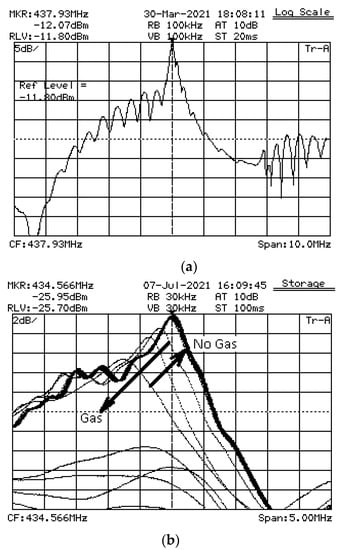
Figure 1.
(a) Typical frequency response of the QSM device used in this study; (b) Illustration of the QSM behavior in the presence of NH3 gas.
2.2. Deposition of the Plasma Polymer Sensing Films
The polymers used in this study were obtained from two monomers: hexamethyldisiloxane for synthesis (HMDSO), Merck® (Hohenbrunn, Germany), and triethylsilane (TES), 99%, AcroSeal® (Germany) in a plasma polymerization process. Synthesis by a plasma polymerization method allows for a well-controlled and reproducible high-deposition rate. Tailoring the physical and chemical properties to a specific application, such as the depth of the surface sorption, as well as the sensitivity and selectivity to certain chemical compounds, is possible by controlling the process parameters and modification of the obtained films. Earlier investigations showed that plasma polymers have a highly branched and cross-linked structure, resulting in excellent adhesion to almost any substrate [11,15]. They are mechanically stable and chemically resistive over changing temperature and time and quickly adsorb and desorb the quantity of the measured gas [5,11]. Moreover, they are elastic, follow the surface deformation of the acoustic device, and do not significantly degrade its loss and Q [10].
The schematic block diagram of the plasma reactor that was used for polymer deposition is shown in Figure 2 [14]. In the reactor chamber, the capacitively coupled glow discharge is generated between two horizontally aligned electrodes, placed 60 mm above each other. By means of a dosing valve VDH016-X, INFICON AG Fl-9496 Balzers (Liechtenstein) monomer vapors enter the chamber. The monomer flow rates for HMDSO and TES were 3.101 mbar·L/s and 1.101 mbar·L/s, respectively. Plasma excitation of the monomer gas was performed at 27.12 MHz using a RF power generator (VEM Indical Berlin, Germany). The current density of the glow discharge was set at 0.16 mA/cm2. The SAW resonators were placed on a teflon plate, which served as a sample holder. In this process, polymerized films built up on the surface of the SAW devices. The thickness of the polymer coatings was estimated from the frequency shift of a mass sensitive quartz resonator used as a quartz crystal microbalance (QCM) before and after deposition. The modification of the deposited polymer films, to increase their NH3 vapor sorption sensitivity, was performed by exposing them for 5 min to ammonia vapors in the same plasma reactor. The modification process was also performed at a 1.101 mbar·L/s NH3 flow rate and a current density of 0.16 mA/cm2.
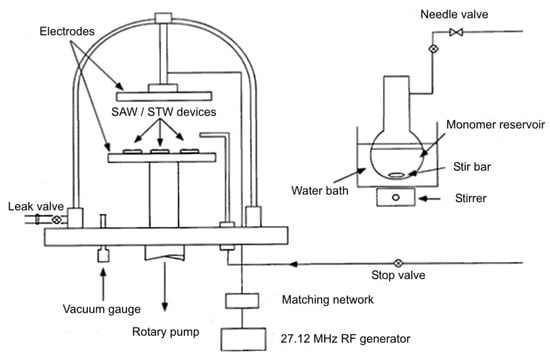
Figure 2.
Schematic of the RF plasma reactor for synthesizing and modification of the sensing films.
2.3. NH3 Gas Probing Setup
A photograph of the gas tower in which the gas probing experiments were performed is shown in Figure 3. Figure 4 shows its schematic diagram. It contains the following basic modules, (see Figure 4):
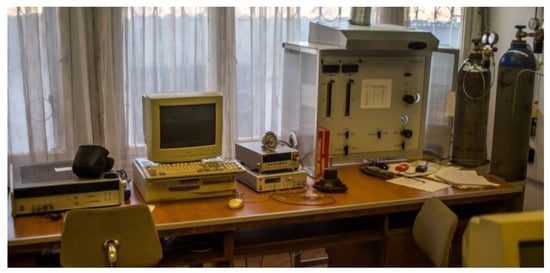
Figure 3.
Photograph of the gas tower used for NH3 probing.
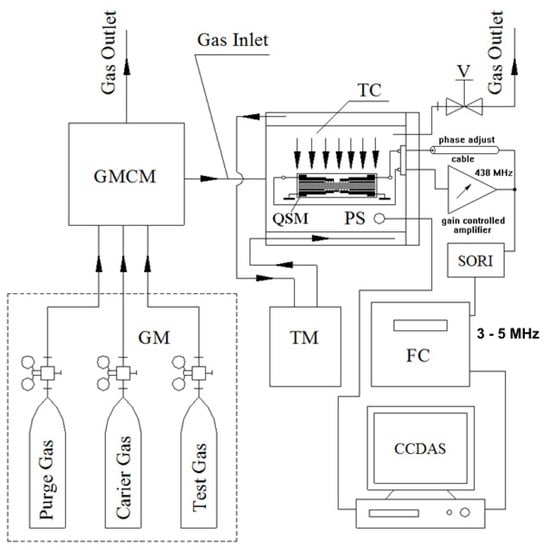
Figure 4.
Block diagram of the gas probing setup.
- Gas module (GM) containing bottles with pure carrier gas (dry air), purge gas (N2) for cleaning the chamber before the measurement, and test gas (NH3). All gases used were free from water vapors;
- Gas mix and control module (GMCM), which includes two mass flow controllers (FC-260 and FC-280) and a mixing chamber;
- Test chamber (TC) with a Pt-thermo sensor (PS) and the mass sensitive QSM mounted inside
- Thermostat module (TM) for providing constant temperature inside the TC;
- Sensor oscillator and readout interface (SORI)
- Frequency counter (FC)
- Computer control and data acquisition system (CCDAS)
The temperature of the sample was measured using a Pt-thermo sensor placed close to it. First, the chamber is N2-flushed, and then a test gas, (NH3 in this case), with a desired concentration is injected until a gas flow at a stable constant rate is reached. The flow rates of both the carrier and test gases are measured and controlled by calibrated mass flow controllers, so that their ratio ensures the desired concentration. The sensor oscillator and readout interface (SORI) is based on the oscillator principle and consists of several building blocks, as shown in Figure 5. The QSM sensor device is mounted on a gold plated printed circuit board (PCB), attached to the bottom of the flange and covering the gas probing setup, as shown in Figure 5a. The QSM is connected to the PC via short wires attached to the QSM contact pads using indium droplets. Gold plated coaxial connectors, mounted on the left and right side of the PCB, are used to provide cable connection to the gain controlled feedback loop amplifier in Figure 5b, placed outside of the gas probing chamber. These cables are fed through sealed holes on the test chamber flange and their length is selected in such manner that the phase condition for oscillation is fulfilled as closely as possible to the QSM’s resonance frequency, where the highest oscillator stability and lowest phase noise are obtained [10]. The sustaining amplifier circuit in Figure 5b also has a built-in gain control circuit operating in the 12 to 28 dB gain range, which allows the amplifier gain to be adjusted at 1–2 dB gain compression, to further minimize QSM oscillator phase noise. By means of a 432 MHz fixed-frequency reference SAW oscillator, stabilized with an uncoated QSM device (see Figure 5c), and a broadband frequency down converter (Figure 5d), the QSM oscillator frequency, typically in the 435 to 438 MHz range is then down converted to a low gas proportional intermediate frequency, typically in the 3 to 5 MHz range, which is measured at a high precision with a low-frequency counter. This is shown in Figure 6, which is the block diagram of the SORI.
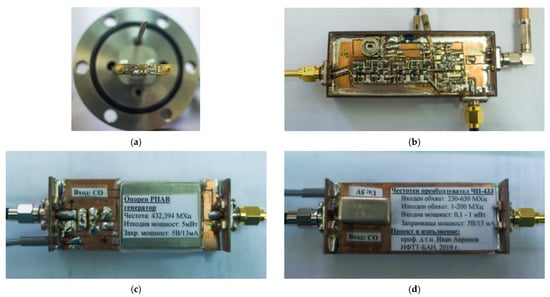
Figure 5.
Building blocks of the QSM readout interface: (a) QSM device, (b) variable gain sustaining amplifier, (c) 432 MHz reference SAW oscillator, and (d) broadband frequency downconverter.
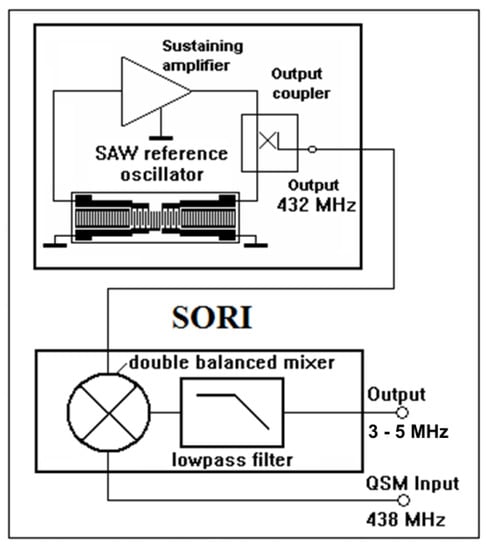
Figure 6.
Block diagram of the SORI.
Further details about the gas probing setup from Figure 4 are provided in [24]. To avoid thermal frequency drifts during long measurements [25], temperature control of the gas chamber is performed by using water circulation through an Ultratemp 2000 Julabo F50 (Seelbach, Germany) thermostat. NH3 gas of a desired concentration is precisely set with the mass flow controllers before entering the gas chamber. A measurement of the intermediate frequency is taken once in every 2 s after the gas has been applied to the QSM, until equilibrium is reached. Then the QSM is either flushed with dry air or exposed to a different NH3 concentration, depending on the desired measurement method: probe/flush cycling or saturation exposure. The behavior of the sensor signal and temperature during probing is observed in real time on the computer screen.
2.4. Surface Roughness Measurements
Finally, surface roughness measurements on modified and unmodified films are performed with a Taylor-Hobson Talystep (Leicester, UK) profilometer. For accurate measurements, this device is calibrated with the provided calibration standard.
3. Results and Discussion
The first gas probing experiment was performed with two QSM samples, A and C, coated with PPHMDSO for 30 min at a 0.16 mA/cm2 glow discharge current density. Sample C was then plasma modified with NH3 vapors for another 5 min. Then both samples were NH3 probed on three consecutive days, (measurements 1, 2, and 3 in the data plots to follow). Gas probing was performed in the gas tower from Figure 3 at 50, 150, 250, and 500 ppm concentrations without air flushing, to test the sorption ability of the PPF prior to and after NH3 modification. The above NH3 concentrations were precisely set by the calibrated mass flow controllers inside the GMCM unit in Figure 4. The results are compared in Figure 7a,b. Please note that these two measurements were performed on two different samples: one unmodified and one modified. The modified sample adsorbed more gas; therefore, it took somewhat longer to reach equilibrium. This is the reason why the measurement in Figure 7a was interrupted at 9500 s, while the one in Figure 7b was stopped at 12,500 s. The influence of temperature was eliminated by thermostatic control of the temperature within ±0.1 K inside the test chamber in Figure 4, using water circulation.

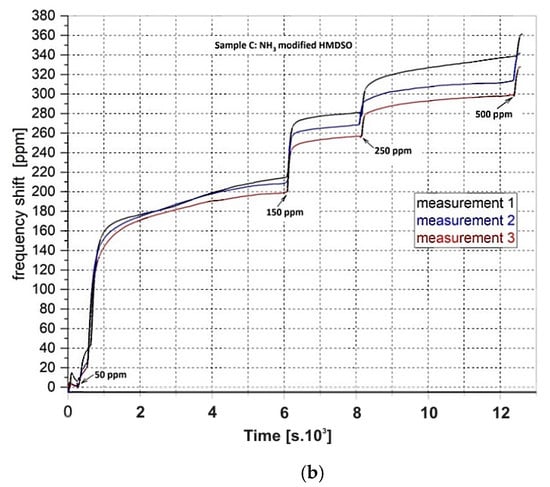
Figure 7.
NH3 gas probing results from two PPHMDSO coated samples (a) without and (b) with NH3 modification. No air flushing was applied at the gas concentration jumps.
The data plots in Figure 7 clearly demonstrate the effect of the NH3 plasma modification on the affinity of the PPHMDSO layer to NH3. On the one hand, plasma modification significantly increases the sorption ability of the film; from 210 ppm (unmodified), to 360 ppm for the modified film, (see data from measurement 1 in Figure 7b). Moreover, the jumps at the different NH3 concentrations are much deeper and better behaved compared to the unmodified film. There is a slight decrease in sorption ability between measurement 1, 2, and 3, which is observed with both the modified and unmodified films. This indicates that residues of the probing gas permanently stay in the layer. However, we found that in real-life measurements with air flushing, only one NH3 treatment of the modified layer is sufficient to fully avoid further permanent accumulation of NH3 molecules in the modified film. This is evident from the data plots in Figure 8, indicating a more significant sorption reduction only after the first measurement. At the high 150, 250, and 500 ppm concentrations, however, the probing performance remained unchanged. Another proof of this is given by the reproducibility test in Figure 9, where the modified Sample C was gas probed for three further measurements on three further consecutive days. A perfect reproducibility of the three data plots is observed after only one NH3 treatment, according to Figure 8.
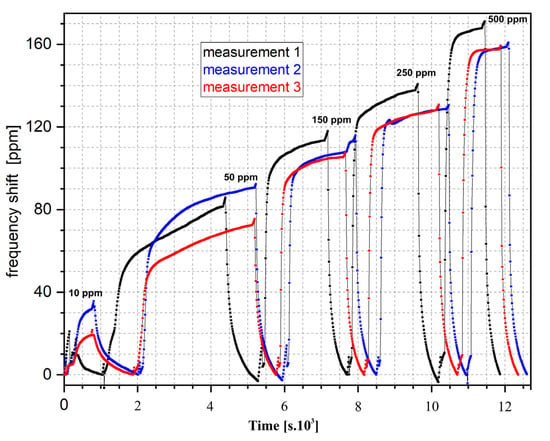
Figure 8.
Effect of the first NH3 treatment on the sorption ability of the modified PPHMDSO film. The differences between measurements 2 and 3 at the low 10 and 50 ppm NH3 concentrations are attributed to higher gas sensitivities at those concentrations, and irrelevant at the high concentrations of interest.
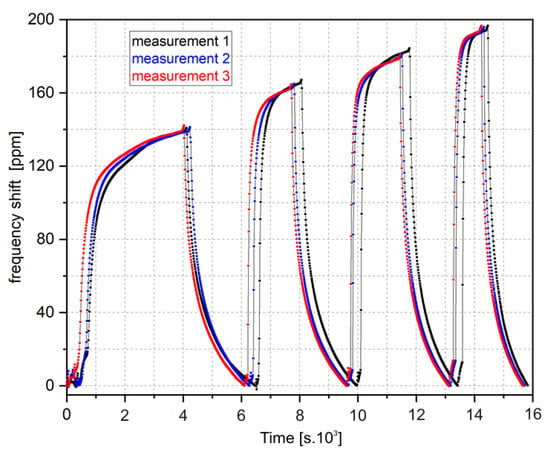
Figure 9.
Reproducibility test of a modified PPHMDSO film after only a single treatment with NH3. The time axis from curve to curve has been slightly shifted horizontally for a better visual comparison. NH3 concentrations from left to the right: 50, 150, 250, and 500 ppm.
Figure 10 compares the real-life NH3 probing behavior of the HMDSO coated QSM with and without modification measured at the four NH3 concentrations from Figure 9. A significant 74% to 85% improvement in NH3 sensitivity was observed with the plasma modified film.
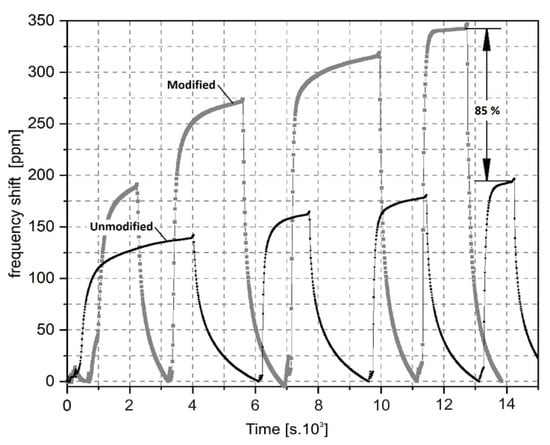
Figure 10.
Sensitivity comparison of the modified (upper curve) vs. unmodified (lower curve) PPHMDSO coated QSM in real-life NH3 probe-flush measurements.
Finally, the modification effect was also tested with TES, which is different from the HMDSO chemical compound, since it also contains nitrogen atoms in its molecule. We expected these N atoms to contribute to an increased affinity of the PPTES films to NH3. The comparative results shown in Figure 11 also indicate a sensitivity improvement, although it was only about 8% when the samples were compared. We believe that a much higher sensitivity improvement can be achieved with PMTES after a careful optimization of the film thickness [10] and plasma parameters. This, however, would go beyond the scope of this paper and will be subject of future work.
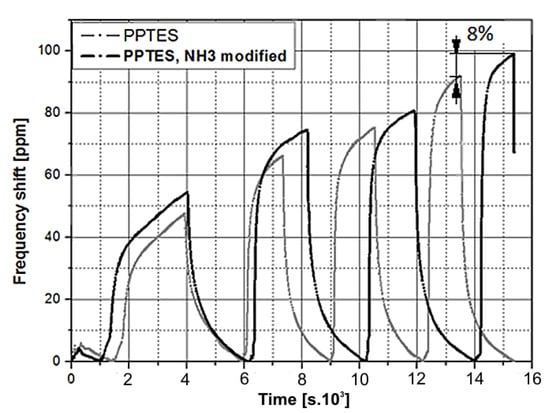
Figure 11.
Sensitivity comparison of the modified (upper black curve) vs. unmodified (lower grey curve) PPTES coated QSM in real-life NH3 probe-flush conditions.
A Possible Explanation of the Plasma Modification Effect
In our opinion, there are two possible reasons for the observed sensitivity enhancement of the plasma modified sensor films.
- A.
- Modification can change the surface roughness of the sensing film, increasing the contact surface area and the penetration depth of the probing gas, which should enhance sensor sensitivity;
- B.
- Plasma modification with the gas of interest creates physical bonds to its molecules on the surface of the sensing film. This increases the film affinity to that same gas.
To check which of these two assumptions is true, we measured the surface roughness of a HMDSO coated sample prior to, and after, plasma modification with NH3, using the profilometer from Section 2.4. The results are compared in Figure 12a,b, respectively. It is clearly seen that plasma modification reduces surface roughness, which should decrease the probing sensitivity. Reference [26] also presents scanning electron microscopy (SEM) data in support of this statement. However, in all the experiments from Section 3 we observe the opposite effect: the sensitivity is increased after plasma modification. The explanation of this phenomenon is highlighted in [15,16,27]. The ammonia plasma treatment of polymers used as NH3 sensing films is aimed at creating suitable centers for improved affinity to NH3 molecules, to enhance their sorption performance. According to Ref. [28], for polymers obtained from HMDSO, such centers were detected by IR spectroscopic ellipsometry and atomic force microscopy (AFM) techniques. Furthermore, the plasma modification by NH3 vapors in the IR ellipsometric spectra leads to the appearance of a new absorption band at 1562 cm−1, indicating the presence of N–H deformation in amines [28]. There is no additional layer, due to the ammonia plasma treatment, but, despite this fact, a change in optical thickness was also observed [28]. This change is a clear indication of a modified surface morphology. Further AFM examination also confirmed a substantial reorganization of the polymer surface [28]. The size of the surface nodules and nodule aggregates was greatly reduced in the modified polymer [15,28]. This is also seen in Figure 12a,b. Plasma modified HMDSO films feature reversible physical sorption. A possible explanation of this process could be dipole–dipole interactions as a result of van der Waals forces between the molecules of the sensing film and the NH3. We assume that for the second modified plasma polymer PMTES a similar sorption mechanism also takes place. These assumptions and data rule out possibility A above, and lead us to believe that the real reason for the enhanced sensitivity to the gas of interest (NH3 in this case) is the creation of physical surface bonds increasing the affinity of the sensing layer to that same gas, as suggested by possibility B.
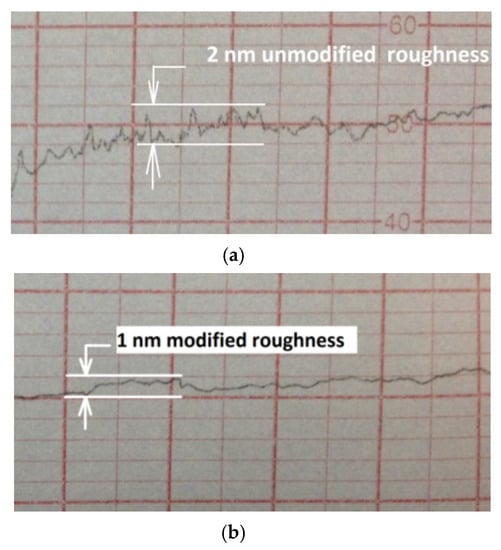
Figure 12.
Surface roughness of a PPHMDSO film (a) prior to and (b) after NH3 modification. One small vertical division corresponds to 1 nm.
4. Summary and Conclusions
We have demonstrated a significant increase in the probing sensitivity of plasma polymer sensing films, as used in QSM-based SAW gas sensors. By plasma modification of the film surface with molecules of the gas of interest, the sensitivity to that gas is increased. We observed up to an 85% sensitivity improvement to NH3 in PMHMDSO sensing layers that were NH3 modified and about an 8% improvement in modified PMTES films with different chemical compounds containing N atoms in their molecule. This insignificant 8% sensitivity improvement in PMTES did not meet our expectations that nitrogen will substantially enhance the affinity to NH3. However, we believe that, after careful film thickness, plasma parameter, and modification optimizations, the PMTES film sensitivity to ammonia can also be further increased. In our opinion, the method demonstrated in this work could greatly enhance sensitivity and dynamic range in PPF functionalized QSM based sensors operating at high concentrations of the sensed chemical compounds. This is confirmed by comparing the average sensitivities (AS) and limits of detection (LOD) of the QSM sensors in this work with similar sensors from earlier works, including the classical QCM, (see Table 1). The AS values for the PMHMDSO and PMTES coated devices were derived from the data in Figure 10 and Figure 11. The LOD values were calculated according to the method described in [10], with a short-term stability of the 438 MHz QSM sensor oscillator measured as 6 × 10−8/s under real-life NH3 probing conditions in the gas tower from Figure 3. The significant improvement in the LOD of the current sensors compared to the earlier NH3 devices from Table 1 clearly demonstrates the advantages of the QSM technology for SAW based sensor systems.

Table 1.
Comparison of the current QSM results with data from earlier work on similar SAW based NH3 sensors, including the classical thickness-shear mode QCM.
Further work is necessary to also test the method on other types of plasma polymer films and apply it to sensing other gases of interest, such as the highly toxic NO2, VOC, and BTX [8,32,33], etc. The authors plan such studies in the near future.
Author Contributions
Conceptualization, I.A. and E.R.; methodology, I.A., E.R., and Y.L.; software, validation, Y.L.; formal analysis, I.A.; investigation, resources, data curation T.G. and L.V.; writing—original draft preparation, editing, I.A.; visualization, Y.L. and T.G. All authors have read and agreed to the published version of the manuscript.
Funding
This research was entirely funded by the Bulgarian Academy of Sciences and did not receive external funding.
Institutional Review Board Statement
Not applicable.
Informed Consent Statement
Not applicable.
Data Availability Statement
.Data is contained within the article.
Acknowledgments
The authors wish to gratefully acknowledge the Institute of Microstructure Technology at the Karlsruhe Institute of Technology, Germany for providing the two-port SAW resonator devices used in this study.
Conflicts of Interest
The authors declare no conflict of interest.
References
- Yatsuda, H.; Nara, M.; Kogai, T.; Aizawa, H.; Kurosawa, S. STW gas sensors using plasma-polymerized allylamine. Thin Solid Film. 2007, 515, 4105–4110. [Google Scholar] [CrossRef]
- Ten, S.T.; Hashim, U.; Gopinath, S.C.B.; Liu, W.W.; Foo, K.L.; Sam, S.T.; Rahman, S.F.A.; Voon, C.H.; Nordin, A.N. Highly sen-sitive Escherichia coli shear horizontal surface acoustic wave biosensor with silicon dioxide nanostructures. Biosens. Bioelectron. 2017, 93, 146–154. [Google Scholar] [CrossRef] [PubMed]
- Raj, V.B.; Singh, H.; Nimal, A.; Sharma, M.; Tomar, M.; Gupta, V. Distinct detection of liquor ammonia by ZnO/SAW sensor: Study of complete sensing mechanism. Sens. Actuators B Chem. 2017, 238, 83–90. [Google Scholar] [CrossRef]
- Lamanna, L.; Rizzi, F.; Bhethanabotla, V.R.; De Vittorio, M. Conformable surface acoustic wave biosensor for E-coli fabricated on PEN plastic film. Biosens. Bioelectron. 2020, 163, 112164. [Google Scholar] [CrossRef] [PubMed]
- Grabka, M.; Jasek, K.; Pasternak, M. Application of polymethyl [4 -(2,3-difluoro-4-hydroxyphenoxy)butyl] siloxane in sur-face acoustic wave gas sensors for dimethyl methylphosphonate detection. Sens. Actuators B. Chem. 2021, 329, 129216. [Google Scholar] [CrossRef]
- Rapp, M.; Reibel, J.; Stier, S.; Voigt, A.; Bahlo, J. SAGAS: Gas Analyzing sensor systems based on surface acoustic wave devices—An issue of commercialization of SAW sensor technology. In Proceedings of the IEEE International Frequency Control Symposium, Orlando, FL, USA, 28–30 May 1997; pp. 129–132. [Google Scholar]
- Ritter, F.; Hedrich, J.; Deck, M.; Ludwig, F.; Shakirov, D.; Rapp, B.; Länge, K. Polymer Structures on Surface Acoustic Wave Biosensors. Procedia Technol. 2017, 27, 35–36. [Google Scholar] [CrossRef]
- Kus, F.; Altinkok, C.; Zayim, E.; Erdemir, S.; Tasaltin, C.; Gurol, I. Surface acoustic wave (SAW) sensor for volatile organic compounds (VOCs) detection with calix [4] arene functionalized Gold nanorods (AuNRs) and silver nanocubes (AgNCs). Sens. Actuators B Chem. 2021, 330, 129402. [Google Scholar] [CrossRef]
- Thomas, S.; Racz, Z.; Cole, M.; Gardner, J.W. Dual high-frequency Surface Acoustic Wave Resonator for ultrafine particle sensing. In 2013 IEEE SENSORS; Institute of Electrical and Electronics Engineers (IEEE): Baltimore, MD, USA, 2013; pp. 1–4. [Google Scholar]
- Avramov, I.D. Polymer Coated Rayleigh SAW and STW Resonators for Gas Sensor Applications. In Acoustic Waves—From Microdevices to Helioseismology; Marco, G.B., Ed.; IntechOpen: Rijeka, Croatia, 2011; Chapter 23; pp. 521–546. ISBN 978-953-307-572-3. Available online: www.intechopen.com/books/show/title/acoustic-waves-from-microdevices-to-helioseismology (accessed on 14 November 2011).
- Radeva, E.I.; Avramov, I.D. Humidity Sensing Properties of Plasma Polymer Coated Surface Transverse Wave Resonators. In Proceedings of the 1998 IEEE International Ultrasonics Symposium, Sendai, Japan, 5–8 October 1998; pp. 509–512. [Google Scholar]
- Stahl, U.; Voigt, A.; Dirschka, M.; Barié, N.; Richter, C.; Waldbaur, A.; Gruhl, F.J.; Rapp, B.E.; Rapp, M.; Länge, K. Long-Term Stability of Polymer-Coated Surface Transverse Wave Sensors for the Detection of Organic Solvent Vapors. Sensors 2017, 17, 2529. [Google Scholar] [CrossRef] [Green Version]
- Avramov, I.D.; Länge, K.; Rupp, S.; Rapp, B.; Rapp, M. Polymer coating behavior of Rayleigh-SAW resonators with gold electrode structure for gas sensor applications. IEEE Trans. Ultrason. Ferroelectr. Freq. Control. 2007, 54, 157–166. [Google Scholar] [CrossRef]
- Avramov, I.; Kurosawa, S.; Rapp, M.; Krawczak, P.; Radeva, E. Investigations on plasma-polymer-coated SAW and STW resonators for chemical gas-sensing applications. IEEE Trans. Microw. Theory Tech. 2001, 49, 827–837. [Google Scholar] [CrossRef]
- Alemán, C.; Fabregat, G.; Armelin, E.; Buendía, J.J.; Llorca, J. Plasma surface modification of polymers for sensor applications. J. Mater. Chem. B 2018, 6, 6515–6533. [Google Scholar] [CrossRef] [PubMed] [Green Version]
- Bolbasov, E.N.; Antonova, L.V.; Stankevich, K.S.; Ashrafov, A.; Matveeva, V.G.; Velikanova, E.A.; Yu, I.K.; Hodyrevskaya, Y.; Kudrysavtseva, A.; Anissimov, Y.G.; et al. The use of magnetron sputtering for the deposition of thin titaniumcoatings on the surface of bioresorbable electrospun fibrous scaffoldsfor vascular tissue engineering. A pilot study. Appl. Surf. Sci. 2017, 398, 63. [Google Scholar]
- Fan, Y.; Li, X.; Yang, R. The Surface Modification Methods for Constructing Polymer-Coated Stents. Int. J. Polym. Sci. 2018, 2018, 1–7. [Google Scholar] [CrossRef]
- Rao, J.; Bao, L.; Wang, B.; Fan, M.; Feo, L. Plasma surface modification and bonding enhancement for bamboo compo-sites. Compos. Part B Eng. 2018, 138, 157–167. [Google Scholar] [CrossRef]
- Jang, H.; Jung, E.; Parsons, T.; Tae, H.-S.; Park, C.-S. A Review of Plasma Synthesis Methods for Polymer Films and Nanoparticles under Atmospheric Pressure Conditions. Polymers 2021, 13, 2267. [Google Scholar] [CrossRef] [PubMed]
- Kwak, D.; Lei, Y.; Maric, R. Ammonia gas sensors: A comprehensive review. Talanta 2019, 204, 713–730. [Google Scholar] [CrossRef] [PubMed]
- Comotti, M.; Frigo, S. Hydrogen generation system for ammonia–hydrogen fuelled internal combustion engines. Int. J. Hydrog. Energy 2015, 40, 10673–10686. [Google Scholar] [CrossRef]
- Lin, T.H.; Li, Y.T.; Hao, H.C.; Fang, I.C.; Yang, C.M.; Yao, D.J. Surface acoustic wave gas sensors for monitoring low concentration ammonia. In Proceedings of the 2011 16th International Solid-State Sensors, Actuators and Microsystems Conference, Beijing, China, 5–9 June 2011; pp. 1140–1143. [Google Scholar]
- Avramov, I.D.; Stahl, U. On the mass sensitivity of Rayleigh surface acoustic wave (RSAW) resonators. In 2017 40th International Spring Seminar on Electronics Technology (ISSE); Institute of Electrical and Electronics Engineers (IEEE): Sofia, Bulgaria, 2017; pp. 1–6. [Google Scholar]
- Georgieva, V.; Stefanov, P.; Spassov, L.; Raicheva, Z.; Atanassov, M.; Tincheva, T.; Manolov, E.; Vergov, L. Thin MoO3 films for sensor applications. J. Optoelectron. Adv. Mater. 2009, 11, 1363–1366. [Google Scholar]
- Esmeryan, K.D.; Avramov, I.D.; Radeva, E.I. Temperature Frequency Characteristics of Hexamethyldisiloxane (HMDSO) Polymer Coated Rayleigh Surface Acoustic Wave (SAW) Resonators for Gas-Phase Sensor Applications. Micromachines 2012, 3, 413–426. [Google Scholar] [CrossRef]
- Radeva, E. A SEM Study of Plasma Polymerized Hexamethyldissiloxane Thin Films. Vacuum 1997, 47, 41–42. [Google Scholar] [CrossRef]
- MacGregor, M.; Vasilev, K. Perspective on Plasma Polymers for Applied Biomaterials Nanoengineering and the Recent Rise of Oxazolines. Materials 2019, 12, 191. [Google Scholar] [CrossRef] [Green Version]
- Tsankov, D.; Radeva, E.; Hinrichs, K.; Röseler, A.; Korte, E.-H. Infrared spectroscopic ellipsometry and atomic force mi-croscopy study of plasma polymerized hexamethyldisiloxane layers post-treated by NH3 plasma. Thin Solid Film. 2005, 476, 174–180. [Google Scholar] [CrossRef]
- Constantinoiu, I.; Miu, D.; Viespe, C. Surface Acoustic Wave Sensors for Ammonia Detection at Room Temperature Based on SnO2/Co3O4 Bilayers. J. Sens. 2019, 2019, 1–6. [Google Scholar] [CrossRef] [Green Version]
- Zhu, H.; Xie, D.; Lin, S.; Zhang, W.; Yang, Y.; Zhang, R.; Shi, X.; Wang, H.; Zhang, Z.; Zu, X.; et al. Elastic loading enhanced NH3 sensing for surface acoustic wave sensor with highly porous nitrogen doped diamond like carbon film. Sens. Actuators B Chem. 2021, 344, 130175. [Google Scholar] [CrossRef]
- Trajcheva, A.; Politakos, N.; Bertha, T.; Joseph, P.Y.; Gilev, J.B.; Tomovska, R. QCM nanocomposite gas sensors—Expanding the application of waterborne polymer composites based on graphene nanoribbon. Polymer 2021, 213, 123335. [Google Scholar] [CrossRef]
- Han, D.; Zhai, L.; Gu, F.; Wang, Z. Highly sensitive NO2 gas sensor of ppb-level detection based on In2O3 nanobricks at low temperature. Sens. Actuators B Chem. 2018, 262, 655–663. [Google Scholar] [CrossRef]
- Caoa, J.; Wang, S.; Li, J.; Shang, Y.; Zhao, X.; Li, D. Porous nanosheets assembled Co3O4 hie archical architectures for enhanced BTX (Benzene, Toluene and Xylene) gas detection. Sens. Actuators B Chem. 2020, 315, 128120. [Google Scholar] [CrossRef]
Publisher’s Note: MDPI stays neutral with regard to jurisdictional claims in published maps and institutional affiliations. |
© 2021 by the authors. Licensee MDPI, Basel, Switzerland. This article is an open access article distributed under the terms and conditions of the Creative Commons Attribution (CC BY) license (https://creativecommons.org/licenses/by/4.0/).